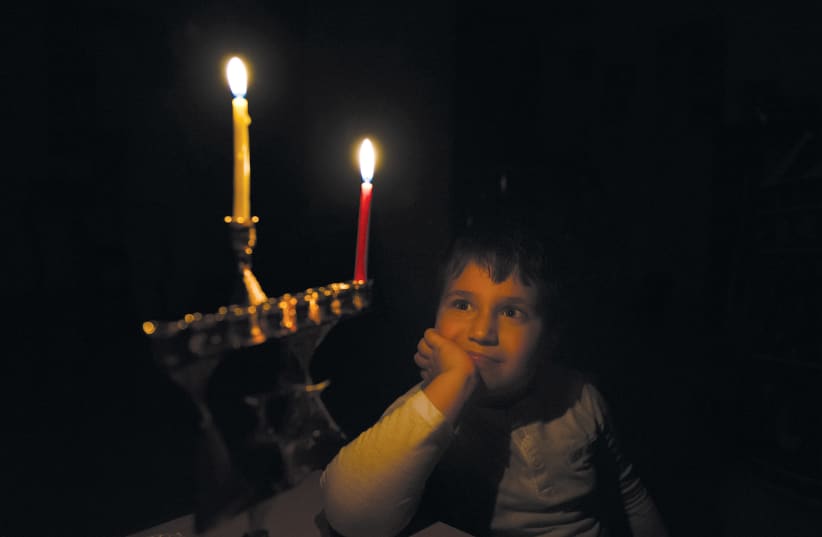As a child, I grew up in Britain, Israel and Australia. It’s the lot of being the child of community leaders – teachers and rabbis – that we don’t stay in one place too long, as there is always a new challenge, a community that needs spiritual and practical leadership. There are many challenges and even more benefits, in my opinion, to this lifestyle including getting to know people, cultures and practices all over the world.
However, one year as a young teenager, I was struck by the dissonance between what I and my family do in our Jewish lives at this time of year, and what is happening around us in the general populace.
There I was lighting my little candle, while up and down the streets were Christmas lights decorating houses, inflatable Santas in front yards. The shopping malls were decked in boughs of holly; giant trees with gifts piled high enticed shoppers to come and take part in the festivities. And there I was, lighting a little candle.
And yet, I’m not alone. I’m not alone in these feelings, but more importantly, I’m not alone in performing the actions that lead to these feelings. Lighting Hanukkah candles, getting dressed up on Purim, attending a Seder, and other expressions of Jewish practice are not something that’s limited to only certain segments of the Jewish world, but is truly common to us all, no matter where we are living.
WHEN RESEARCHING Jewish practices, the 2013 Pew Research Center came to the following conclusion:
Jewish Americans found that attending a Seder is an extremely common practice for the group. While only 23% of US Jews said they attend religious services at least monthly, 70% said they participated in a Seder last year. That includes 42% of Jews of no religion (those who consider themselves Jewish in some way, were raised Jewish or had a Jewish parent, but say they are atheist or agnostic, or have no particular religion.)
This number is higher than those who fast, at least partially, on Yom Kippur (53%) or light candles for Shabbat (23%). It shows the centrality of the Seder in Jewish life, particularly in comparison with other standard, daily or weekly, Jewish practices.
The numbers for participation in other festivals is also higher than the daily or weekly Jewish rituals, and we know from our emissaries around the world that more people take an active role and are engaged in Jewish life around the festivals than they are during the year.
What’s the secret? What is it about the festivals sprinkled throughout the Jewish calendar that speaks to people of all ages and backgrounds?
One answer is, of course, food. Each festival has its own unique menu: some based in biblical commandments, such as matzah on Passover, or the opposite – not eating on Yom Kippur; some based on rabbinic sources, such as dairy products on Shavuot; and others based on individual and local traditions, such as the different types of oily delicacies devoured in Jewish communities throughout the world on Hanukkah.
Another answer is that the festivals are a time for family. While there is a definite religious component and additional prayers and Torah readings associated with each of the festivals, a large part of marking the festivals affords people with the opportunity to spend time together.
This enables families to imbue each festival with their own personal take, from topics of conversation, songs and tunes, culinary aspects and more. It’s not always easy to come together as a family unit, and Shabbat – and to a greater extent, the festivals – encourage “holy convocation” as the Torah describes it; meeting and gathering in the glow of the festivals and their deeper meanings.
HOWEVER, THE secret isn’t in any one of these or other components, but rather a combination, a symbiosis of elements. Judaism, as a religion and a way of life, affords the opportunity for individuals and communities to infuse their own thoughts, feelings and practices into what they do and how they do it.
While certain parts are halachically mandated (which not everyone keeps or even feels the need to do so), there is still plenty that can be added and fine-tuned to make the connection personal.
It’s the active participation during these festive times that enables a young teenager to develop a personal and religious identity. It’s what enables us as individuals, families and communities to stand up both to ourselves and also in the face of other cultures, and show pride in who we are, in our ongoing story.
Lord Rabbi Jonathan Sacks, of blessed memory, writes: “Hanukkah is about the freedom to be true to what we believe without denying the freedom of those who believe otherwise. It’s about lighting our candle, while not being threatened by or threatening anyone else’s candle.”
Or in other words, and as I was taught as a young child learning Hanukkah songs, kol echad hu or katan, each one of us is a small light. It’s not just that we light a small light, but we, ourselves, are the small light; vechulanu or eitan, but together, we are a powerful light. When we come together, united as a family, as a community, as a multifaceted Jewish nation, we are powerful, we are proud, and we can ultimately fulfill our purpose of being a light to others.
The writer, a rabbi, is the director of education for the Beren-Amiel & Straus-Amiel Institute of Ohr Torah Stone.
